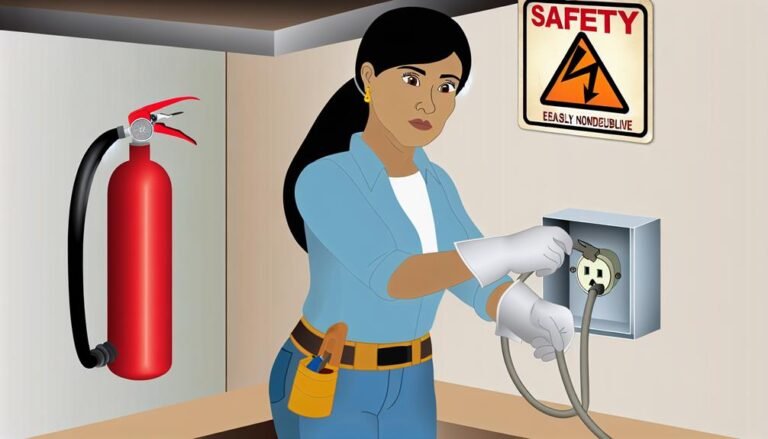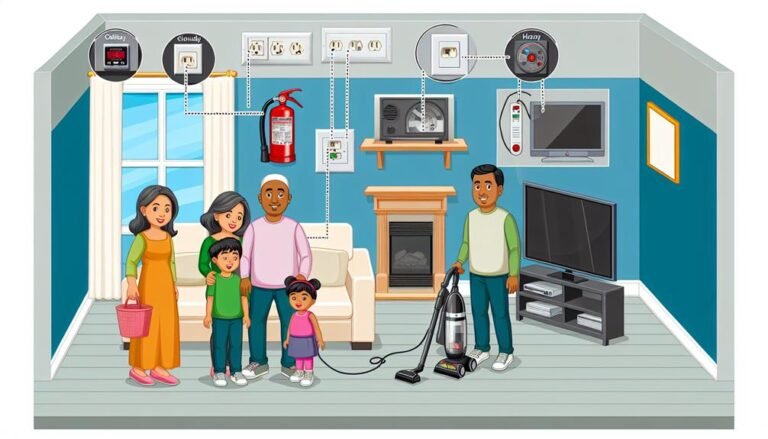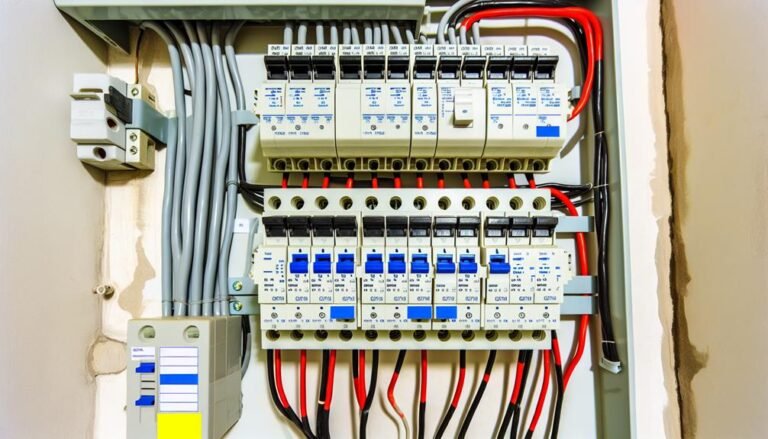Stay secure and safeguard your sanctuary by steering clear of electrical hazards that can pose serious risks. From faulty wiring to overloaded circuits, there are five common dangers that demand your attention.
These potential pitfalls can lurk in the corners of your home, silently waiting to strike. But fear not, for with a little knowledge and precaution, you can minimize the threat and protect yourself and your loved ones from the shocking consequences.
So, let's uncover these hazards and shed light on the steps you can take to ensure a safe haven within your walls.
Key Takeaways
- Promptly identify and address faulty wiring to prevent fires and electrical shocks.
- Avoid overloading circuits by spreading out the load and using different outlets or circuits.
- Regularly inspect electrical cords for signs of damage and replace them immediately.
- Properly use extension cords, checking their maximum load capacity and avoiding damaged cords.
Faulty Wiring
To ensure the safety of your home and prevent electrical accidents, it's crucial to identify and address any instances of faulty wiring promptly. Faulty wiring poses significant fire hazards and increases the risk of electrical accidents in your home. Faulty wiring can result from a variety of factors, including outdated electrical systems, improper installation, or wear and tear over time.
One common sign of faulty wiring is frequent tripping of circuit breakers or blown fuses. If you notice this happening regularly, it may indicate an underlying wiring problem that needs to be addressed. Another warning sign is flickering lights or dimming when you use certain appliances. This could indicate a loose connection or overloaded circuit.
It is important to address faulty wiring immediately to prevent potential fire hazards. Faulty wiring can cause sparks or electrical arcs, which can ignite nearby flammable materials and lead to a devastating fire. Furthermore, faulty wiring can also result in electrical shocks, which can cause severe injuries or even be fatal.
To address faulty wiring, it's recommended to hire a licensed electrician who can inspect your electrical system and identify any issues. They can then make the necessary repairs or updates to ensure the safety of your home.
Overloaded Circuits
Overloading circuits can lead to electrical hazards and should be avoided to ensure the safety of your home. When you overload a circuit, you exceed its capacity and put it at risk of overheating. This can result in fire hazards and electrical fires.
To prevent these dangers, it's essential to understand the signs of an overloaded circuit and take necessary precautions:
- Pay attention to frequent circuit breaker tripping: If your circuit breaker trips often, it's a clear indication that the circuit is being overloaded. Resetting the breaker without addressing the issue can lead to potential electrical fires.
- Avoid using too many electrical appliances on a single circuit: Plugging in multiple high-power devices, such as heaters, air conditioners, and kitchen appliances, can overload the circuit. Spread out the load by using different outlets or circuits.
- Be cautious of extension cords and power strips: While these can be convenient, they have limitations. Overloading them by connecting too many devices can cause overheating and increase the risk of electrical fires.
Damaged Electrical Cords
Damaged electrical cords pose a significant risk of electrical hazards and should be promptly addressed to ensure the safety of your home. Proper electrical cord maintenance is crucial in preventing cord damage and potential accidents.
Regularly inspecting your electrical cords for signs of wear and tear is essential. Look out for frayed or exposed wires, cracked or broken insulation, and loose or damaged plugs. If you notice any signs of damage, it's important to replace the cord immediately. Avoid using electrical cords that have been repaired with tape or temporary fixes, as they can be unreliable and unsafe.
To prevent cord damage, avoid placing heavy objects on cords, pulling cords out from the outlet by yanking on the cord itself, and running cords under carpets or rugs where they can be easily damaged. Additionally, make sure to unplug cords by gripping the plug itself rather than pulling on the cord.
Improper Use of Extension Cords
Inspecting and maintaining electrical cords is only one aspect of home safety. Another important consideration is avoiding the improper use of extension cords. Improper usage of extension cords can lead to electrical hazards and increase the risk of fires or electric shocks.
To ensure extension cord safety and proper extension cord usage, keep the following points in mind:
- Avoid overloading: Plugging too many appliances or devices into a single extension cord can overload it and cause overheating. Make sure to check the maximum load capacity of the extension cord and never exceed it.
- Don't use damaged cords: Using extension cords with frayed wires, exposed conductors, or broken plugs can be extremely dangerous. Always inspect the cords for any signs of damage before use, and if any issues are found, replace the cord immediately.
- Use the right cord for the job: Different extension cords are designed for different purposes. Be sure to choose the appropriate cord for the intended use, considering factors such as length, gauge, and whether it's rated for indoor or outdoor use.
Lack of Ground Fault Circuit Interrupters (GFCIs)
To ensure electrical safety in your home, it is crucial to address the issue of lacking Ground Fault Circuit Interrupters (GFCIs). GFCIs are an essential safety feature that protect against electrical shocks and fires caused by ground faults. A ground fault occurs when an electrical current takes an unintended path to the ground, potentially passing through a person's body. GFCIs detect these imbalances in current and quickly shut off power to prevent harm.
The importance of GFCIs cannot be overstated. They are particularly crucial in areas where water is present, such as kitchens, bathrooms, and outdoor outlets. Without GFCIs, the risk of electrical accidents and injuries significantly increases. Take a look at the table below to understand the potential risks and benefits of installing GFCIs in your home:
| Risk without GFCIs | Benefit of GFCIs |
|---|---|
| Electrical shocks | Protection against harmful electrical shocks |
| Fires caused by ground faults | Prevention of fires due to ground faults |
| Increased risk in wet areas | Enhanced safety in areas exposed to water |
Installing GFCIs is a simple yet effective way to ensure electrical safety in your home. It is recommended to have GFCIs installed by a qualified electrician, who can properly assess your electrical system and determine the best locations for installation. Remember, your safety and the safety of your loved ones should always be a top priority.








